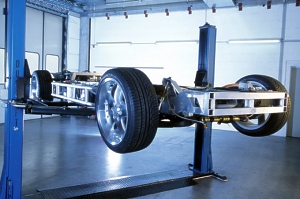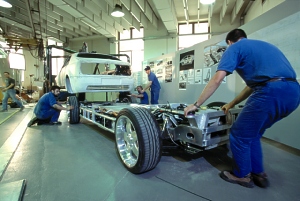
.
. .
..
. . .
Hummer Cars GM Concepts 2003 GM Concepts 2002 GM Concepts 2001
© 1998 - 2004
Copyright &
|
.
General Motors: Hy-wire Global Teamwork PARIS - GM's Hy-wire is a rolling symbol of 21st century global corporate teamwork.
"In a very short period of time, we developed a harmonious, intercontinental cooperation between all the people involved despite the many cultural differences," said Chris Borroni-Bird, director of GM's Design and Technology Fusion Group and program director of the Hy-wire concept.
So how did GM and its partners do it? Apart from the enthusiasm for the exciting joint project, the smooth cooperation was made easier by the high-tech satellite and virtual reality facilities installed at GM's U.S. and Germany fuel cell centers, said Christof Scherl, fuel cell system integration manager at GM's research facility in Mainz-Kastel. The 500 people working at the three research facilities have direct video conferencing facilities for discussing technical matters. "In this way it was possible, for example, to look at a three-dimensional view of the concept vehicle simultaneously on both sides of the Atlantic," Borroni-Bird said. "Special software allowed us to view and discuss fine details of the construction and, if necessary, make changes right away." According to Alan Rhodes, sculpting manager at GM Design, transmitting the vehicle's digital data to Bertone so that the interior and exterior could be interpreted as the American designers intended presented a few challenges. "Once we developed Hy-wire's shape, we had to make sure that the digital data would transmit quickly and compatibly with Bertone's systems," Rhodes said. "We now have a system in place that makes communication with Bertone extremely good." The intercontinental cooperation that resulted in Hy-wire's rapid development is rooted in GM's commitment to expand its fuel-cell research and development program in the late 1990s. Previous achievements include the development of the HydroGen1 fuel cell vehicle, which set 15 world speed and distance records for fuel cell vehicles, a stationary fuel cell for distributed power generation, and numerous improvements in fuel cell stack and fuel processor development. "We are making outstanding progress in our fuel-cell technology," said Larry Burns, GM's vice president of Research and Development and Planning. "Over the last four years, we've decreased the size and weight of our fuel-cell stack for a given power by a factor of 10 and achieved a tenfold reduction in cost." GM's latest-generation stack has a proven density of 1.75 kilowatts per hour - the highest power output announced by any fuel cell developer to date. Substantial improvements in sub-zero temperature start-up have also been achieved. To meet the requirements of this new technology, the GM fuel-cell teams include many specialists from disciplines whose backgrounds are outside the automotive industry. For example, chemists, physicists, software specialists and electrical engineers are all involved in the fuel cell and hydrogen storage technology development. "Intellectual property is vital for this key technology," said Erhard Schubert, director of GM's fuel cell development center in Germany. "The multi-faceted knowledge of our research experts provides the best possible conditions for us to succeed, and it will secure an important market lead for GM." GM expects to have a significant number of fuel cell vehicles on the road by 2010. According to Burns, "Hy-wire strengthens our confidence in our ability to gain marketplace acceptance of production fuel cell vehicles. "We are leveraging our talent and expertise around the world so that we can deliver vehicles like Hy-wire by the end of the decade."
|
|



















